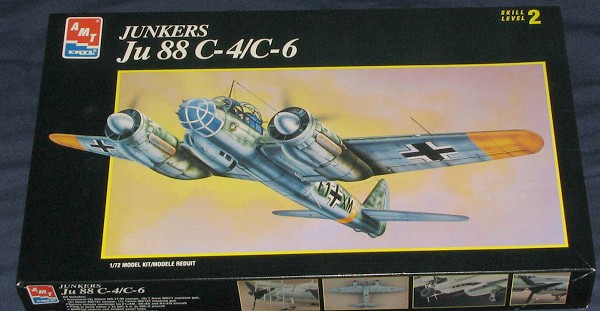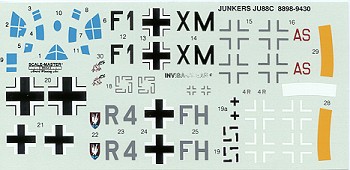
| KIT: | AMT 1/72 Ju-88C-4/6 |
| KIT #: | 8898 |
| PRICE: | $12.98 MSRP when new |
| DECALS: | Three options |
| REVIEWER: | Scott Van Aken |
| NOTES: | Kit box date is 1994. Now OOP |

| HISTORY |
The Ju-88C models were the first of the 'heavy fighter' versions of this fast bomber. Based on the Ju-88A-5 bomber and entering production in late 1940, the C models featured a solid gun nose without the bombardier's equipment. On the C-4, there were three MG 17 machine guns and one MG 151 15mm cannon, or two MG-FF and two MG-FFM cannon located in the gondola. Only about 65 of the C-4 versions were build and in 1941 it was replaced by the C-6.
The C-6 was based on the later Ju-88A-4 version and had the asymmetrical bulges under the engines that were typical of the Jumo 211J engines. The nose armament was identical to the C-4 but the defensive armament in the cabin was changed to two guns. Many C-6s were issued to bomber groups to act as escorts and as ground attack aircraft. By 1943, the C-6 was called upon more and more for night fighting. Late production C-6s were equipped with FuG 220 antenna and flame damping exhaust covers. The lower gondola was removed to shed some weight. It was finally replaced in 1944 by the Ju-88G version. Often the C-6 3was re-engined with the BMW 801 radial engines in place of the inline Jumo 211s. This was as much to bring back lost performance due to increasing weight as to making the aircraft faster.
| THE KIT |
 Despite
Italeri producing a lot of Ju-88 variants, AMT also decided to do the Ju-88
in 1/72. The main reason was due to the myriad of variants that can be
produced using pretty much the same basic parts. To that end, AMT released
this kit and the Ju-88G night fighter before they decided that they weren't
making any money doing aircraft and stopped aircraft model production. In
more recent history, AMtech has taken these AMT base kits and produced
several very nice Ju-88 variants by adding in the required bits to do
Ju-88H, S, and T versions.
Despite
Italeri producing a lot of Ju-88 variants, AMT also decided to do the Ju-88
in 1/72. The main reason was due to the myriad of variants that can be
produced using pretty much the same basic parts. To that end, AMT released
this kit and the Ju-88G night fighter before they decided that they weren't
making any money doing aircraft and stopped aircraft model production. In
more recent history, AMtech has taken these AMT base kits and produced
several very nice Ju-88 variants by adding in the required bits to do
Ju-88H, S, and T versions.
Though it is blessed with engraved panel lines, the AMT kits are not the easiest to build as there are definite fit problems, especially the engines. There are also a few inaccuracies, such as too shallow and narrow an engine nacelle. However, unless you are really concerned about these things, the kit can be built into a nice model.
So let's have a look at what you get. First of all, it comes in a very large box. This is mostly due to the length of the nacelle/landing gear sprue as otherwise, there is a lot of room in the box. The parts are well molded in a light grey plastic, though there is some flash that appears on some of the sprues and parts. Bits are well packaged with one or sometimes two sprues per package. Those that are specifically for the C versions are in individual packages.
General detail is fairly good. There is detail on the sidewalls of the interior, the engine fronts and inside main gear doors. Nothing outstanding, but more than adequate for most builders. Cockpit has a goodly amount of detail with seats and control sticks and rudder pedals. The clear bits are a tad thick so seeing any of this detail may be a moot point. Engine front detail is fair with the builder having to cut away the appropriate number of openings in the radiator for the variant being built. The flame dampers are half tubes and not the full tubular ones that I'd have expected. However, it is possible that these early night fighters used the half tube version. I have no real references to say one way or the other. If doing a radar equipped C-6 the antennas and masts are butt fit to the nose, not an easy task as I found when doing the 88G.
 Instructions are quite nice
and provide clear diagrams with little subassembly drawings that show
proper alignment of parts or those bits needed for one variant or the
other. They also provide color information in generic name, RLM, or FS 595
as needed. Markings are for three aircraft. First is the C-6 day fighter
version as shown on the box art with the false 'glass' nose from 4./KG 76.
This is in 'Olive Green' over 'Light Blue'. The other C-6 is a night
fighter from 8./NGJ 2 in 'Light Grey' uppers and 'Light Blue' undersides
with 'Medium Grey' patches. FS 595 colors are given for these, though I'd
have liked to have RLM shades provided as well. The final aircraft is a C-4
from 1./NJG 2 in overall black (making it easy to paint). The decal sheet
is by ScaleMaster and it seems as if the white is a bit off register as the
white surround to the F is out of alignment and there is extra white bits
sticking out the side of the insignia. Interestingly, the two piece
swastikas are in register. Go figure.
Instructions are quite nice
and provide clear diagrams with little subassembly drawings that show
proper alignment of parts or those bits needed for one variant or the
other. They also provide color information in generic name, RLM, or FS 595
as needed. Markings are for three aircraft. First is the C-6 day fighter
version as shown on the box art with the false 'glass' nose from 4./KG 76.
This is in 'Olive Green' over 'Light Blue'. The other C-6 is a night
fighter from 8./NGJ 2 in 'Light Grey' uppers and 'Light Blue' undersides
with 'Medium Grey' patches. FS 595 colors are given for these, though I'd
have liked to have RLM shades provided as well. The final aircraft is a C-4
from 1./NJG 2 in overall black (making it easy to paint). The decal sheet
is by ScaleMaster and it seems as if the white is a bit off register as the
white surround to the F is out of alignment and there is extra white bits
sticking out the side of the insignia. Interestingly, the two piece
swastikas are in register. Go figure.
| CONCLUSIONS |
If you are a Ju-88 enthusiast, then this is probably the one to get. Revell did the C version back in the 1960s and this rivet-festooned kit can be found from time to time. However, it is really for collectors as it is just not up to snuff. This one, however, is nice as it is, or with aftermarket bits can be made into a show stopper.
Kit courtesy of me.
November 2004
If you would like your product reviewed fairly and quickly by a site that has nearly 300,000 visitors a month, please contact me or see other details in the Note to Contributors.